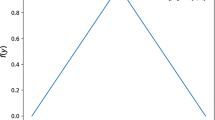Abstract
We describe an error type that we call the naturalizing error: an appeal to nature as a self-justified description dictating or limiting our choices in moral, economic, political, and other social contexts. Normative cultural perspectives may be subtly and subconsciously inscribed into purportedly objective descriptions of nature, often with the apparent warrant and authority of science, yet not be fully warranted by a systematic or complete consideration of the evidence. Cognitive processes may contribute further to a failure to notice the lapses in scientific reasoning and justificatory warrant. By articulating this error type at a general level, we hope to raise awareness of this pervasive error type and to facilitate critiques of claims that appeal to what is “natural” as inevitable or unchangeable.
Similar content being viewed by others
Notes
Ironically, perhaps, this approach respects Bloor (1991) principle of symmetry, by coupling a sociological understanding of false beliefs (error) with a corresponding sociological understanding of the complementary processes that yield correct claims. See especially Bloor’s response to critics (1991, 175–179).
References
Allchin, D. (2001). Error types. Perspectives on Science, 9, 38–59.
Allchin, D. (2006). Male, female and/or—? American Biology Teacher, 68, 372–375.
Allchin, D. (2007a). A more fitting analogy. American Biology Teacher, 69, 174–176.
Allchin, D. (2007b). Teaching science lawlessly. In P. Heering & D. Osewold (Eds.), Constructing scientific understanding through contextual teaching (pp. 13–31). Berlin: Frank & Timme.
Allchin, D. (2012). To be human. American Biology Teacher, 75(2), 132–135.
Allchin, D. (2014). Organisms, modified, genetically. American Biology Teacher, 76, 639–641.
Ayala, F. (1970). Teleological explanations in evolutionary biology. Philosophy of Science, 37, 1–15.
Barkan, E. (1992). The retreat of scientific racism. Cambridge: Cambridge University Press.
Bloor, D. (1991). Knowledge and social imagery (2nd ed.). Chicago: University of Chicago Press.
Bolhuis, J. J., Brown, G. R., Richardson, R. C., & Laland, K. N. (2011). Darwin in mind: New opportunities for evolutionary psychology. PLoS Biology, 9(7), e1001109. doi:10.1371/journal.pbio.1001109.
Brem, S. K., Ranney, M., & Schindel, J. (2003). Perceived consequences of evolution: College students perceive negative personal and social impact in evolutionary theory. Science Education, 87, 181–206.
Browne, J. (1995). Charles Darwin: Voyaging. Princeton: Princeton University Press.
Buller, D. J. (2005). Adapting minds: Evolutionary psychology and the persistent quest for human nature. Cambridge: MIT Press.
Buss, D. (1995). The evolution of desire: Strategies of human mating. New York: Basic Books.
Buss, D. (2007). The evolution of human mating. Acta Psychologica Sinica, 39(3), 505–512.
Canetto, S. S. (1996). What is a normal family? Common assumptions and current evidence. Journal of Primary Prevention, 17, 31–46.
Carlson, A. C. (2015). The natural family where it belongs: New Agrarian essays. Piscataway: Transaction Publishers.
Carlson, A. C., & Mero, P. T. (2007). The natural family: A manifesto. Dallas: Spence. See also http://familymanifesto.net.
Carlson, A. C., & Mero, P. T. (2008). The natural family: Bulwark of liberty. Piscataway: Transaction Publishers.
Carrera-Bastos, P., Fontes-Villalba, M., O’Keefe, J. H., Lindeberg, S., & Cordain, L. (2011). The western diet and lifestyle and diseases of civilization. Research Reports in Clinical Cardiology, 2, 15–35.
Cartwright, N. (1999). The dappled world. Cambridge: Cambridge University Press.
Daston, L., & Stolleis, M. ( Eds). (2008). Natural law and laws of nature in early modern Europe. Farnham: Ashgate.
Dawkins, R. (1995). God’s utility function. Scientific American, 273(5), 80–85.
Dawkins, R. (2006). The god delusion. New York: Houghton Mifflin.
Dennett, D. (1995). Darwin’s dangerous idea: Evolution and the meanings of life. New York: Simon and Schuster.
Desmond, A., & Moore, J. (1994). Darwin: The life of a tormented evolutionist. New York: Norton.
Diamond, J. (1992). The third chimpanzee. New York: Harper Collins.
Etcoff, N. (1999). Survival of the prettiest. New York: Doubleday.
Fee, E. (1979). Nineteenth-century craniology: The study of the female skull. Bulletin of the History of Medicine, 53, 415–433.
Ghiselin, M. (1969). The triumph of the Darwinian method. Chicago: University of Chicago Press.
Gilovich, T. (1991). How we know what isn’t so. New York: Free Press.
Gonzalez Galli, L. M., & Meinardi, E. N. (2010). The role of teleological thinking in learning the Darwinian model of evolution. Evolution: Education and Outreach, 4(1), 145–152. doi:10.1007/s12052-010-0272-7.
Gould, S. J. (1996). The mismeasure of man (2D ed.). New York: Norton.
Haraway, D. (1989). Primate visions: Gender, race, and nature in the world of modern science. New York: Routledge.
Harding, S. (1991). Whose science? Whose knowledge?: Thinking from women’s lives. Ithaca: Cornell University Press.
Huxley, T. H. (1894/1989). Evolution and ethics (Facsimile reprint). Princeton: Princeton University Press.
Kahneman, D. (2011). Thinking, fast and slow. New York: Farrar, Giraud & Strauss.
Kelemen, D. (2004). Are children “intuitive theists”? Psychological Science, 15, 295–301.
Kelemen, D., & Rosset, E. (2009). The human function compunction: Teleological explanation in adults. Cognition, 11, 138–143.
Kohler, W. (1966). The place of value in a world of facts. New York: Mentor Books.
Laland, R. N., & Brown, G. R. (2002). Sense and nonsense: Evolutionary perspectives on human behavior. Oxford: Oxford University Press.
Larsen, C. S. (2003). Equality for the sexes in human evolution? Early hominid dimorphism and implications for mating systems and social behavior. Proceedings of the National Academy of Sciences, USA, 100(16), 9103–9104.
Lewontin, R. C., Rose, S., & Kamin, L. J. (1984). Not in our genes: Biology, ideology and human nature. New York: Pantheon Books.
Lieberman, D. E. (2013). The story of the human body: Evolution, health, and disease. New York: Pantheon Press.
Longino, H. (1990). Science as social knowledge: Values and objectivity in scientific inquiry. Princeton: Princeton University Press.
Mansfield, H. (2006). Manliness. New Haven: Yale University Press.
Moore, G. E. (1903). Principa Ethica. Cambridge: Cambridge University Press.
Moss, L. (2002). What genes can’t do. Cambridge: MIT Press.
Nickerson, R. S. (1998). Confirmation bias: A ubiquitous phenomenon in many guises. Review Of General Psychology, 2, 175–220.
Parker, J. D. (2004). A major evolutionary transition to more than two sexes? Trends in Ecology and Evolution, 19, 83–86.
Putnam, R. A. (1998). Perceiving facts and values. Philosophy, 73, 5–19.
Putnam, H. (2002). The collapse of the fact/value dichotomy and other essays. Cambridge: Harvard University Press.
Richards, R. J. (2003). Darwin on minds, morals, and emotions. In J. Hodge & G. Radick (Eds.), The Cambridge companion to Darwin (pp. 92–115). Cambridge: Cambridge University Press.
Richardson, R. C. (2007). Evolutionary psychology as maladapted psychology. Cambridge: Cambridge University Press.
Ridley, M. (1996). The origins of virtue. New York: Penguin.
Ridley, M. (2010). The rational optimist: How prosperity evolves. New York: Harper Collins.
Rose, S. (2003). Lifelines: Life beyond the gene. Oxford: Oxford University Press.
Rosenbloom, C. (2014). Popular diets and athletes: Premises, promises, pros, and pitfalls of diets and what athletes should know about diets and sports performance. Nutrition Today, 49(5), 244–248.
Roughgarden, J. (2004). Evolution’s rainbow: Diversity, gender, and sexuality in nature and people. Berkeley: University of California Press.
Samaras, T. (2007). Human body size and the laws of scaling: Physiological, performance, growth, longevity, and ecological ramifications. Hauppage: Nova Science.
Schiebinger, L. (1989). The mind has no sex? Cambridge: Harvard University Press.
Schiebinger, L. (1993). Why mammals are called mammals: Gender politics in eighteenth-century natural history. The American Historical Review, 98(2), 382–411.
Shanahan, M. (1994). Unnatural history? Star Tribune, 26 August, 16A.
Sigmund, K., & Hilbe, C. (2011). Darwin and the evolution of human cooperation. In H. Meyer-Ortmanns & S. Thurner (Eds.), Principles of evolution (pp. 331–347). Berlin: Springer.
Smith, D. E. (1993). The Standard North American family: SNAF as an ideological code. Journal of Family Issues, 14, 50–65.
Solomon, M. (2001). Social empiricism. Cambridge, MA: MIT Press.
Steinle, F. (2008). From principles to regularities: Tracing “laws of nature” in early modern France and England. In L. Daston & M. Stolleis (Eds.), Natural law and laws of nature in early modern Europe (pp. 215–232). Farnham: Ashgate.
Stepan, N. (1982). The idea of race in science. London: Macmillan.
Sutherland, S. (1992). Irrationality: Why we don’t think straight. New Brunswick: Rutgers University Press.
Wijngaard, M. (1997). Reinventing the sexes: The biomedical construction of femininity and masculinity. Bloomington: Indiana University Press.
Young, R. (1975). Darwin’s Metaphor: Nature’s place in Victorian culture. Cambridge: Cambridge University Press.
Zuk, M. (2013). Paleofantasy: What evolution really tells us about sex, diet, and how we live. New York: Norton.
Author information
Authors and Affiliations
Corresponding author
Rights and permissions
About this article
Cite this article
Allchin, D., Werth, A.J. The Naturalizing Error. J Gen Philos Sci 48, 3–18 (2017). https://doi.org/10.1007/s10838-016-9336-x
Published:
Issue Date:
DOI: https://doi.org/10.1007/s10838-016-9336-x




